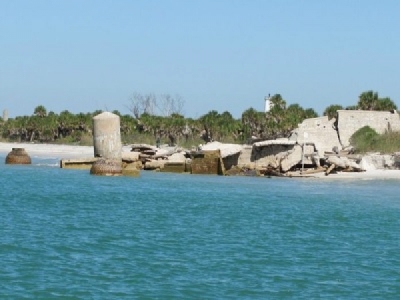
Posted on November 8, 2018
The U.S. Army Corps of Engineers is supplying the weapons in the only battle Fort Dade has ever seen – the one against erosion.
Historic Egmont Key is slated to receive sand to shore up what’s left of the 1899 fort when the Tampa Bay shipping channel is dredged for maintenance beginning this month.
The $10 million project should take about five months to complete.
Egmont’s beaches will not get the high-quality white beach sand recently collected from shoals to its north; that is being used to renourish Pinellas County beaches, according to Pinellas County spokeswoman Ashley Johnson.
Egmont Key, north of Anna Maria Island, will get the sand dredged from 17 miles of the Tampa Harbor Egmont and Mullet Key channel cuts, according to Susan Jackson, of the Corps’ Jacksonville corporate communications office.
The sand will be placed in the middle of Egmont Key’s west side, which faces the Gulf of Mexico, then the project will move to the north end of the island and make its way south, according to the project description.
The dredged material “can be beneficially placed on Egmont Key rather than at a dredge disposal site,” she said.
Nature preserve
The key is protected by both state and federal law as Egmont Key State Park and Egmont Key National Wildlife Refuge, and is a nesting ground for shorebirds and sea turtles, as well as a gopher tortoise preserve.
But the animals don’t seem to mind about the quality of the dredged sand, said Richard Sanchez, president of the Egmont Key Alliance, a citizens’ group working to restore and preserve the key.
Egmont has been renourished with dredged material from the shipping channel before, and sea turtles broke nesting records the last two years, with the 2018 season that ended on Oct. 31 producing 150 nests, he said.
Placing the sand in the early part of the winter season provides time for wave action on the beach to naturally sort the sand and silt, project biologist Aubree Hershorin said, adding, “This is important, because it ensures the beach is as suitable as possible for nesting sea turtles that will begin using the area in April.”
Erosion problem
Egmont Key was used by the U.S. Army to detain Seminole prisoners at the end of the third Seminole War in 1858, and was occupied by both Confederate and Union troops during the Civil War. It later became the site of Fort Dade, begun in 1899 to defend against Spanish attack during the Spanish-American War.
The fort, completed in 1906, served its defensive purpose so well that no battles were ever fought there.
But it has been losing the battle against the Gulf and its storms; parts of the fort are submerged.
The dredge project “will put another Band-Aid on it,” Sanchez said.
Erosion control geotubes installed on the north end of Egmont seem to be holding the Gulf at bay there, he said, although Hurricane Irma moved some of the sand off the north tip in 2017.
A $13 million Corps plan to control erosion and renourish Egmont Key has been in limbo for years, he said. Despite all the required agency approvals being in place, it’s hard to justify funds for a largely-uninhabited nature preserve when people need funds to rebuild from hurricanes, he said.
The island is a temporary home for the Tampa Bay Pilots who maintain living quarters at their docks, where pilot boats transport them to tankers entering and leaving Tampa Bay.
A lighthouse keeper also has quarters on the key. The working lighthouse dates to 1858, and replaced the original lighthouse built 10 years earlier. It is operated by the U.S. Coast Guard as an aid to navigation.
Egmont Key was named for John Perceval, the second Earl of Egmont and a member of the Irish House of Commons who died in 1770. The title “Earl of Egmont” died with the death of the childless Thomas Frederick Gerald Perceval, the 12th Earl of Egmont, in 2011.
The island has been the property of the U.S. Department of the Interior since 1974. Prior to that, it was owned by the U.S. Department of Defense, previously known as the U.S. Department of War. The key has been on the National Register of Historic Places since 1978.
Source: Amisun





